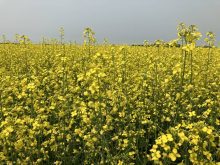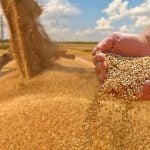* Soybeans rise on technical buying, short-covering
* Profit-taking drags down wheat ahead of USDA reports
* USDA to release production, supply/demand data on Friday (Rewrites throughout, adds quotes, updates prices, changes byline, changes dateline from LONDON)
By Karl Plume
CHICAGO, May 8 (Reuters) – U.S. soybean futures rebounded from three days of losses on Thursday and rose more than 1 percent in a technical and short-covering bounce as investors squared positions ahead of a monthly crop report scheduled for release on Friday.
Wheat futures retreated on profit-taking after hitting a 13-month high earlier in the week and as beneficial rains moved across the U.S. wheat belt, while corn prices churned near previous levels.
Read Also

It’s Your Business: Canola, soybean strength could be short-lived
Spillover from a rising CBOT soy complex has helped push ICE canola futures higher, offering a reprieve — for now, at least — from seasonal harvest pressure and the absence of demand from China.
Attention was turning to Friday’s monthly U.S. Department of Agriculture crop production and supply and demand reports, which will include the government’s first winter-wheat production forecasts of the season and might show a further tightening of U.S. soybean stocks.
“A lot of the action today in beans is just shorts getting out of the market ahead of Friday’s report,” said Rich Nelson, chief strategist with Allendale Inc.
Chicago Board of Trade July soybeans jumped 18 cents, or 1.2 percent, to $14.64-1/4 per bushel by 10:23 a.m. CDT (1523 GMT) after hitting a one-month low the previous day. The contract tested technical support around $14.40 earlier this week but was unable to break that level.
Persistent global demand for soybeans also underpinned the market.
U.S. soybean export demand has slowed seasonally as more South American new-crop beans are available, but there have so far been few cancellations of U.S. sales despite very tight supplies.
Meanwhile, Chinese customs data on Thursday revealed that soybean imports in April were a larger-than-expected 6.5 million tonnes, although analysts noted that shipments to the world’s top importer should begin to slow.
“All the cargoes that Chinese importers booked aggressively in the past months are arriving now, which is supporting prices, but this is also creating a glut of beans,” said Vanessa Tan, investment analyst at Phillip Futures.
“Going forward, let’s say from June onwards, imports should start declining as importers are slowing down.”
Chicago wheat prices eased on improved weather in key U.S. winter wheat areas and as traders exited long positions ahead of Friday’s USDA report.
“The specs are big-time longs in the wheat market, so it’s understandable ahead of first crop-size report of the season in winter wheat, and after the (price) run we have had, it’s understandable to get a consolidation, a bit of profit-taking,” said Tom Fritz, a partner at EFG Group in Chicago.
Investors continue to monitor political tensions in Ukraine, which helped propel prices to the highest in more than a year.
Russian President Vladimir Putin called on Wednesday on pro-Moscow separatists in Ukraine to postpone a vote on secession just five days before it was to be held, potentially pulling Ukraine back from the brink of violent dismemberment.
Pro-Russian separatists on Thursday, however, defied Putin and voted in favour of holding a referendum on independence.
CBOT July wheat fell 7 cents, or 1 percent, to $7.30-3/4 per bushel in its steepest drop in a week. July corn was 1/4 cent lower at $5.13-3/4 a bushel.
Prices at 10:30 a.m. CDT (1530 GMT)
LAST NET PCT YTD
CHG CHG CHG
CBOT corn 514.25 0.25 0.1% 21.9%
CBOT soy 1463.25 17.00 1.2% 11.5%
CBOT meal 480.40 5.50 1.2% 9.8%
CBOT soyoil 40.96 0.13 0.3% 5.5%
CBOT wheat 731.25 -6.50 -0.9% 20.8%
CBOT rice 1554.50 0.00 0.0% 0.2%
EU wheat 207.75 -3.25 -1.5% -0.6%
US crude 100.10 -0.67 -0.7% 1.7%
Dow Jones 16,591 73 0.4% 0.1%
Gold 1287.44 -1.50 -0.1% 6.8%
Euro/dollar 1.3862 -0.0048 -0.3% 1.5%
Dollar Index 79.3660 0.1640 0.2% -0.8%
Baltic Freight 1008 -14 -1.4% -55.7%
(Additional reporting by Julie Ingwersen in Chicago, Naveen
Thukral in Singapore, Nigel Hunt in London; editing by Susan
Thomas and Peter Galloway)














